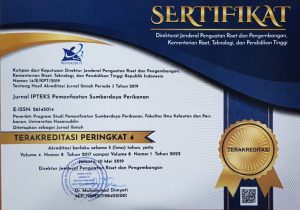Scenario of Scleractinian Larva Dispersal in Sulawesi Waters From A Hydrodynamic Modeling Perspective
DOI:
https://doi.org/10.20956/jipsp.v10i2.30965Keywords:
larval dispersal, modelling, SMS 8.1, spawner coralsAbstract
Scleractinian coral such as Lobophyllia corymbosa that reproduce by external fertilization have an extended planktonic phase in their life cycle during which they "drift" in the water column. This life cycle phase is an advantage in itself because it increases the capacity of propagules to disperse far from their place of origin. In this hydrodynamic model study, secondary data on bathymetry and tides for the western monsoon period (represented by November 2017) were input into the Surface Water Modelling System SMS 8.1 to simulate the surface current circulation model. In running this program there are 2 important stages, namely GFGEN (Geometry File Generation) and RMA2 (Resources Management Associates-2). The simulation of surface current direction during the west monsoon, which is the reproductive period of L. corymbosa in Indonesia, shows the complexity and distraction of current vectors that occur in the coastal waters around Sulawesi Island. The model results indicate the possibility of spatial and temporal biological networks forming in waters around Sulawesi. The current patterns forming in Sulawesi waters during the west monsoon tend to circulate from north to south due to the higher volume of water mass originating from the Pacific Ocean flowing to the southern part of Sulawesi which is also the entry point for the Indonesian Throughflow (ITF). The larval dispersion model scenario produced for each location (Manado, Toli-Toli, Palu, Mamuju, Spermonde, Sinjai, Wakatobi, and Luwuk Banggai) tended to follow the water movement patterns, with most propagules leaving the location where they were spawned.Downloads
References
Adame MCG, Batchelder HP, and Spitz YH. (2017). Modeling Larval Connectivity of Coral Reef Organisms in the Kenya-Tanzania region. Front. Mar., Sci. 4:92.
Affandy Z, Damar A, Agus SB. (2017). Kajian Konektivitas Ekologi Karang pada Kawasan Konservasi Perairan (Studi Kasus: Taman Wisata Perairan Kapoposang. Thesis. Institut Pertanian Bogor.
Connolly SR and Baird AH. (2010). Estimating dispersal potential for marine larvae: dynamic models applied to scleractinian corals. Ecology, 91, 3572–3583. DOI: 10.1890/10-0143.1.
Cowen RK, Sponaugle S. (2009). Larval dispersal and marine population connectivity. Annual Review of Marine Science, 1(1):443–466.
Dobrovolskis AR, and Ingersoll AP. (1980). Atmospheric tides and the rotation of Venus: I. Tidal theory and the balance of torques, Icarus, 41, 1–17, doi:10.1016/0019‐1035(80)90156‐6.
Giyanto, Abrar M, Hadi TA, Budiyanto A, Hafitz M, Salatalohy A. dan Iswari MY. (2017). Status Terumbu Karang Indonesia 2017. COREMAP-CTI. Pusat Penelitian Oseanografi-LIPI. Jakarta.
Gordon AL, Sprintall J, van Aken HM, Susanto RD, Wijffels S, Molcard R, Ffield A, Pranowo W, Wirasantosa S. (2010). The Indonesian Throughflow during 2004–2006 as observed by the INSTANT program. Dyn. Atmos. Oceans 50, 115–128.
Gordon AL, Susanto RD and Ffield A. (1999). Throughflow within Makassar Strait. Geophys. Res. Lett. 26, 3325–3328.
Graham NAJ, McClanahan TR, MacNeil MA, Wilson SK, Polunin NVC, Jennings S. et al. (2008). Climate warming, marine protected areas and the ocean‐scale integrity of coral reef ecosystems. PLoS ONE, 3, e3039.
Hutabarat S. (2001). Pengaruh Kondisi Oseanografi Terhadap Perubahan Iklim, Produktivitas dan Distribusi Biota Laut. Pidato Pengukuhan Guru Besar. Fakultas Perikanan dan Ilmu Kelautan. Universitas Diponegoro. Serang.
Krueck NC, Ahmadia GN, Green A, Jones GP, Possingham HP, Riginos C, Treml EA, and Mumby PJ, (2017). Incorporating larval dispersal into MPA design for both conservation and fisheries. Ecological Applications 27: 925–941.
Lequeux BD, Ahumada-Sempoal MA, López-Pérez A, et al. (2018). Coral connectivity between equatorial eastern Pacific marine protected areas: A biophysical modeling approach, PloS one, 13(8), DOI:10.1371/journal.pone.0202995.
Nathan R and Muller-Landau HC. (2000). Spatial patterns of seed dispersal, their determinants, and consequences for recruitment. Trends in Ecology & Evolution, 15, 278-285.
Peliz A, Marchesiello P, Dubert J, Marta-Almeida M, Roy C and Queiroga H. (2007). A study of crab larvae dispersal on the Western Iberian Shelf: physical processes J. Mar. Sys. 68 215–36.
Storlazzi CD, McManus MA, Logan JB, and McLaughlin BE. (2006). Cross-shore velocity shear, eddies, and heterogeneity in water column properties over fringing coral reefs: West Maui, Hawaii. Cont. Shelf Res. 26, 401–421. doi: 10.1016/j.csr.2005.12.006.
Strathmann RR, Staver RM, and Hoffman JR. (2002). Risk and the evolution of cell-cycle durations of embryos. Evolution, 56: 708 – 720.
Tay Y, Todd P, Rosshaug P, et al. (2012). Simulating the transport of broadcast coral larvae among the Southern Islands of Singapore, Aquatic Biology, 15:283-29.
Vollmer SV and Palumbi SR. (2007). Restricted Gene Flow In The Caribbean Staghorn Coral Acropora cervicornis: Implications For The Recovery Of Endangered Reefs. J Hered 98: 40–50.
Wolanski E, Asaeda T and Imberger J. (1989). Mixing across a Iutocline. Limnology and Oceanography. 34 (5), 931-8.
Wyrtki K. (1987). Indonesian through flow and the associated pressure gradient. Journal of Geophysical Research 92: doi: 10.1029/JC092iC12p12941. issn: 0148-0227.
Downloads
Published
Issue
Section
License
Copyright (c) 2023 Jurnal IPTEKS Pemanfaatan Sumberdaya Perikanan

This work is licensed under a Creative Commons Attribution 4.0 International License.










